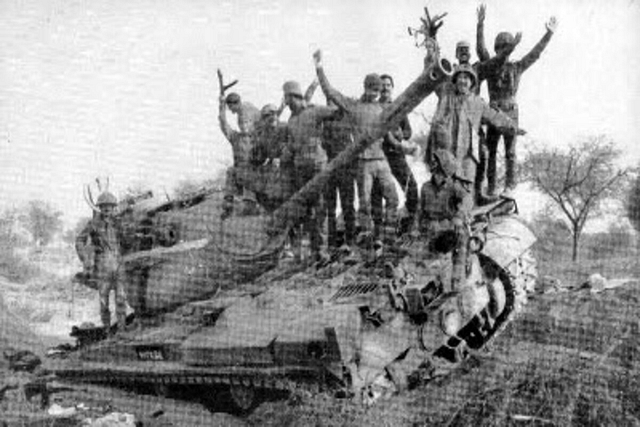Defence
On This Day, In 1971, Indian Tanks Rolled Into Pakistan's Heartland At Shakargarh Bulge, Marking The Beginning Of The Fierce Battle Of Basantar

Indian Army personnel celebrate on top of a knocked out Pakistani Patton tank. (Image via Wikipedia)
On this day, in 1971, the Indian Army launched a corps-sized armoured thrust into Pakistan's heartland at the Shakargarh bulge, an engagement that would be widely known as the 'Battle of Basantar’.
The thrust launched on the intervening nights of 5/6 December was led by the Army’s 1st Corps, against Pakistan army's own 1st Corps deployed in the Sialkot sector.
The assault's main aim was to safeguard the road and rail communications between Pathankot and Jammu, which runs very close (sometimes even 5 to 15 miles) to the bulge, and vital areas like Akhnoor, Jammu, Samba, Madhopur, and Pathankot, and to make sure that Pakistan's 1st Corps gets committed early in the war, making it unavailable for further employment in other sectors.
Capturing as much territory as possible to be used in negotiations was also one of the objectives. This offensive also served the dual purpose of preventing the Pakistan Army from launching its own offensive.
Meanwhile, as the army's armoured and infantry columns moved into the Shakargarh Bulge, the Indian Air Force (IAF) maintained pressure and continued to bombard Pakistan's military installations in support of the Indian Army, including the bombing of the Attock refinery.
The IAF launched 22 counter-air missions, further targeting Pakistani airfields and virtually halting all counter air missions by the Pakistan Air Force (PAF) on the western front.
Most PAF fighter jets were moved deep into the rear on the western front, due to relentless bombings by IAF Canberras and Hunters of various airfields and military installations, including early-warning elements like radars.
According to the IAF, close to 150 sorties were flown on the western front, in the area opposite Sind, in support of army land operations, while another 93 sorties were flown in the east to hasten the rapid advance of the Indian army.
The PAF, according to the IAF, "chose not to come to the party." The IAF adds, "the balance between strategic, counter-air, and offensive support air campaigns was now being reset."
India's indigenously-made HF-24 Marut also scored its first air-to-air kill of a Pakistani US-made F-86 Sabre jet, marking a historical achievement.
The IAF provided support to armoured formations moving into Pakistan, with more than 44 sorties conducted for air-defence cover.
The 'Battle of Basantar' was one of the most significant tank-vs-tank battles of the war, which ultimately resulted in an Indian Army victory with 48 enemy tanks destroyed.
The engineers played their part admirably, clearing a 1,400-metre wide minefield on the soft riverbed of the river Basantar. The Army also withstood repeated and fierce counter-attacks by the Pakistan Army.
These attacks, coupled with the debilitating naval strikes of Operation Trident and sustained air raids, decisively shifted the war's momentum in India's favor.
Support Swarajya's 50 Ground Reports Project & Sponsor A Story
Every general election Swarajya does a 50 ground reports project.
Aimed only at serious readers and those who appreciate the nuances of political undercurrents, the project provides a sense of India's electoral landscape. As you know, these reports are produced after considerable investment of travel, time and effort on the ground.
This time too we've kicked off the project in style and have covered over 30 constituencies already. If you're someone who appreciates such work and have enjoyed our coverage please consider sponsoring a ground report for just Rs 2999 to Rs 19,999 - it goes a long way in helping us produce more quality reportage.
You can also back this project by becoming a subscriber for as little as Rs 999 - so do click on this links and choose a plan that suits you and back us.
Click below to contribute.
Latest